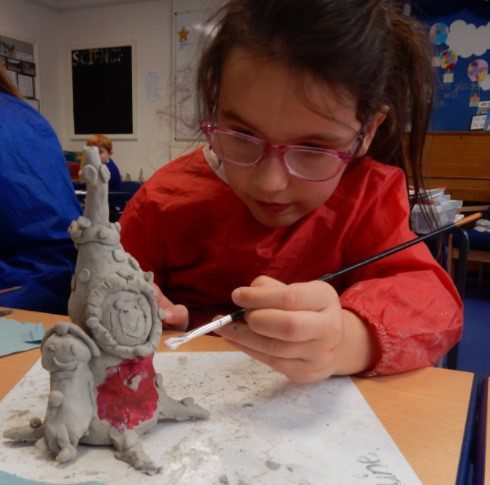“Every child is an artist. The problem is how to remain an artist once he grows up.”
– Pablo Picasso
Art and Design subject lead: Mrs. A Wardle
“Every child is an artist. The problem is how to remain an artist once he grows up.”
– Pablo Picasso
Art and Design subject lead: Mrs. A Wardle
Our Art curriculum inspires children to think innovatively and develop creative procedural understanding and show respect for each other’s work. Children are provided with opportunities to develop skills using a range of media and materials. They learn the skills of drawing, painting, printmaking, collage, textiles and 3D work and are given the opportunity to explore and evaluate different creative ideas.
Children will be introduced to a range of works and develop knowledge of the styles and vocabulary used by famous artists. The skills they acquire are embedded by means of appropriate tasks. We instil a sense of faith in the children’s individual creativity; be this as a means of expression or to explore the styles of other artists (including those linked to our community) that inspire our own work. In Art, children are encouraged to take risks and experiment and then reflect and evaluate their work, thinking about how they can make changes and keep improving.
Progression of appropriate subject knowledge, skills and understanding in exploring and investigating, creating and evaluating artwork, as set out in the National Curriculum, will be clear through the school so that children can reach and exceed their potential and make use of art effectively in their everyday lives.
Children in Key stage 1 and 2 at Saint Augustine Webster will be taught art and design in focused teaching sessions that sit within a curriculum sequence built around the principles of interleaving and spaced retrieval practice using the CUSP scheme. Teaching Art and Design in this way, allows the curriculum to be studied in depth; pupils will have time to complete longer pieces of work over the course of a block rather than in short weekly sessions.
Vertical progression in each discipline has been deliberately woven into the fabric of the curriculum so that pupils can revisit key disciplines throughout their Primary journey at increasing degrees of challenge and complexity. In addition to the core knowledge required to be successful within each discipline, the curriculum outlines key aspects of artistic development in the Working Artistically section. Each module will focus on developing different aspects of these competencies. This will support teachers in understanding pupils’ development as artists more broadly, as well as how successfully they are acquiring the taught knowledge and skills.
Central to the learning modules are activities designed to develop pupils’ oracy and vocabulary skills to enable them to use artistic language meaningfully when talking about their work and the work of others. An overview of the core content provides information about the skills covered across the term in each year group. This enables teachers to see the progression of skills covered within each aspect of Art and Design

The desired impact of our Art and Design curriculum is to encourage pupils to develop their creativity and imagination, to explore their ideas and communicate them using a variety of media. Our curriculum will engage, inspire and challenge pupils, equipping them with the knowledge and skills to experiment, invent and create their own works of art, craft and design. Art and Design will promote the pupil’s spiritual, moral, social and cultural development by creating opportunities and activities for pupils to develop their self-esteem and confidence inside and beyond the classroom. Pupils will be encouraged to create, reflect, become independent learners and develop their team work skills. Art and Design will promote British Values by ensuring children develop their understanding of how art and design both reflect and shape our history, and contribute to the culture, creativity of our nation. Art and Design will help pupils develop a Growth Mindset by encouraging the children to challenge themselves by allowing them to experiment, invent and create their own works of art, craft and design.
We will measure the impact of the Art curriculum through:
If you were to walk into Art lessons at Saint Augustine Webster CVA you would see:
Children evaluating their own and other’s artwork using technical vocabulary